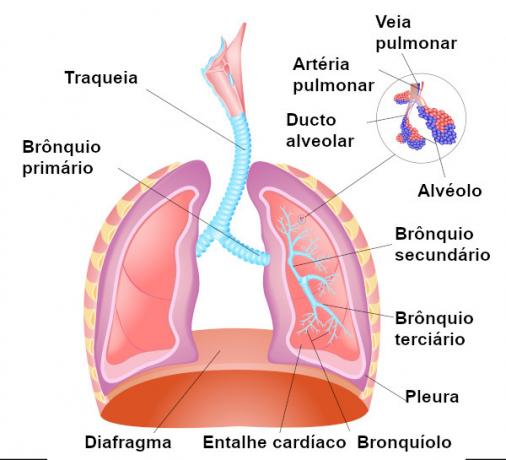You peptides are formed by amino acids which are joined by peptide bonds. A peptide can be formed by two or more amino acids, being called a polypeptide when many amino acids are forming its structure.
Peptides are extremely important, presenting a great diversity of biological roles, like the role of hormone. THE insulin, for example, it is a polypeptide hormone produced in the pancreas, which is responsible for ensuring the entry of glucose in the cells, decreasing the amount of glucose in the blood.
Read too: Noradrenaline - hormone of the catecholamine family
What are amino acids?
Before we can better understand what peptides are, we must understand what amino acids are. organic molecules that constitute them. All amino acids have a basic structure, owning a , called the alpha carbon (α).
To the alpha carbon are attached:
a group amino,
a carboxyl group,
an atom of hydrogen, asymmetric carbon
a variable group, which is called the R group or side chain.
This side chain is responsible for differing one amino acid from another.

They exist 20 amino acids, which are used to build the most varied proteins, because, just as the letters of the alphabet can combine and form different words, these organic molecules can link in different ways, constituting different polypeptide chains.
What are peptides?
The peptides are linked amino acid chainsthrough peptide bonds, in which the carboxyl group of one amino acid binds to the amino group of another. When two amino acids link together, we have a dipeptide. Three linked amino acids form a tripeptide, four amino acids a tetrapeptide, five amino acids a pentapeptide, and so on. is often called oligopeptides the molecule made up of less than ten amino acid units. Many linked amino acids form the so-called polypeptides.
It is clear, therefore, that peptides vary in size, with peptides made up of a few amino acids up to thousands. Regardless of their size, peptides have a linear amino acid sequence, and one end has a free amino group, while the other end has a carboxyl group. Thus, a peptide always has a amino end (N-terminus) and a carboxyl end (C-terminus). The chemical nature of the molecule is determined by the sequence of side chains it presents.
Do not stop now... There's more after the advertising ;)
What is the function of peptides?
Peptides have several functions in the body, being recognized peptides that act as:
hormones,
neurotransmitters,
neuromodulators.
It's worth making it clear that there is no relationship between the size of a polypeptide and its importance., existing peptides with two amino acids, for example, that have an important function. An example of an important and commercially used dipeptide is the aspartame, which is used as a sweetener.
As other examples of peptides of great importance, we can cite the peptide hormones, which include insulin, glucagon and the hormones produced by the hypothalamus and the hypophysis.
Read too: Major endocrine glands and their hormones
Polypeptides and proteins

Although many people think that polypeptides and proteins are synonymous, this is not true, and it is possible to differentiate them based on molecular mass:
the polypeptides have a molecular weight below 10,000,
proteins have a high molecular weight, above 10,000.
In addition, the functional proteins, even when formed by only one polypeptide chain, they are organized in a complex way, being the sequence of amino acids present in the polypeptide chain responsible for determining the three-dimensional structure of these proteins.
The structure of each protein is directly related to its function in the body. It is worth noting that proteins have a series of functions existing, for example:
contractile proteins, involved, for example, with Muscular contraction;
structural proteins such as collagen and elastin;
transport proteins;
receptor proteins;
defense proteins, such as antibodies.
By Vanessa Sardinha dos Santos
Biology teacher
Would you like to reference this text in a school or academic work? Look:
SANTOS, Vanessa Sardinha dos. "Peptides"; Brazil School. Available in: https://brasilescola.uol.com.br/biologia/peptideos.htm. Accessed on June 28, 2021.
Chemistry

Peptides, elemental unit in the constitution of a protein, Amine function, Carboxylic acid function, amphoteric compounds, essential amino acids, valine, lysine, tryptophan, leucine, isoleucine, phenylalanine, methionine, threonine, composition of nucleopro

